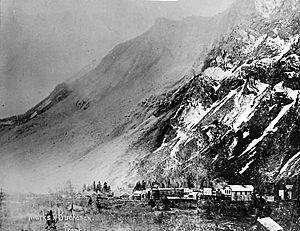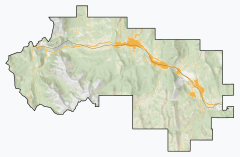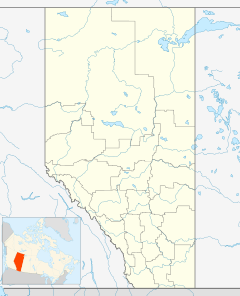Frank, Alberta facts for kids
Quick facts for kids
Frank
|
|
|---|---|
|
Former village
|
|
| Country | Canada |
| Province | Alberta |
| Specialized municipality | Municipality of Crowsnest Pass |
| Village | September 3, 1901 |
| Amalgamated | January 1, 1979 |
| Government | |
| • Type | Unincorporated |
| Area
(2021)
|
|
| • Land | 4.09 km2 (1.58 sq mi) |
| Population
(2021)
|
|
| • Total | 147 |
| • Density | 35.9/km2 (93/sq mi) |
| Time zone | UTC−7 (MST) |
| • Summer (DST) | UTC−6 (MDT) |
Frank is a small community in the Rocky Mountains of southwest Alberta, Canada. It is part of the Municipality of Crowsnest Pass. Frank used to be its own village. However, in 1979, it joined with four other nearby communities to form the larger Crowsnest Pass municipality.
Contents
History of Frank

The Frank Slide in 1903, shortly after it happened.
|
The Start of a Mining Town
In 1901, two American businessmen, Sam Gebo and Henry Frank, started a coal mine. It was located at the base of Turtle Mountain in the Crowsnest Pass area. In May of that year, the first buildings were put up for the new community of Frank. It was built on flat land between the Canadian Pacific Railway tracks and the mine.
Frank officially became a village on September 3, 1901. Its grand opening was held on September 10, 1901. This was a big all-day event with sports, tours of the mine, a fancy dinner, and a dance. Two special trains brought guests and food, including a ton of ice cream!
Henry Frank led the event. Important people like the premier (the leader of the province) Frederick W. A. G. Haultain and other government ministers attended. Frank was the first village to be officially formed in the Crowsnest Pass. By 1903, it had about 1,000 people, many businesses, a two-story brick school, and a regional post office.
The Frank Slide Disaster
On April 29, 1903, a huge rockslide called the Frank Slide happened. It destroyed much of the mine's equipment and seven houses on the edge of Frank. Between 70 and 90 people lost their lives.
Despite the disaster, the mine reopened within weeks. The railway line was also quickly rebuilt through the slide area. Frank continued to grow. In 1905 and 1906, a new area for homes was built north of the railway tracks. This helped keep up with the mine's production.
A new zinc smelter (a factory that melts metal) and a large three-story hotel were also built. The hotel, called the Rocky Mountains Sanatorium, was near a cold sulphur spring. A small zoo was even built near the hotel.
Decline and Amalgamation
However, Frank's growth did not last. The zinc smelter never actually opened because of market problems. It was later turned into an ice skating rink. People also worried about another rockslide. Because of these fears, the government ordered the closure of the south part of town in 1911. Over the next few years, buildings there were torn down or moved.
The part of town built in 1905 remained. But Frank became less important after the mine closed temporarily in 1912 and then permanently in 1917. The sanatorium hotel became a military hospital in 1917. It was torn down in 1928 after being empty for some time. The post office finally closed in 1968.
On November 3, 1978, the Government of Alberta passed a law to combine several communities. This led to the official joining, or amalgamation, of the Village of Frank. It joined with the Village of Bellevue, the Town of Blairmore, the Town of Coleman, and Improvement District No. 5. This new, larger municipality, the Crowsnest Pass, was formed on January 1, 1979.
Frank Today
The Frank Slide area was named a Provincial Historical Resource in 1977. In 1985, the provincial government opened a special centre in Frank. This centre explains the Frank Slide and the history of coal mining in the area.
The place where the original Frank townsite stood is now an industrial park. Many of the old buildings in the northern part of town are gone. This includes Gebo's large house and the Catholic church, which was blown down by wind in 1917.
However, some houses are still over a hundred years old. Visitors can also see parts of old wood-stave water pipes in Gold Creek. They can also find pieces of the zinc plant's foundation and an old fire hydrant in the former townsite.
Population of Frank
| Population history of Frank | ||||||||||||||||||||||||||||||||||||||||||||||||||||||||||||||||||||||||||
|---|---|---|---|---|---|---|---|---|---|---|---|---|---|---|---|---|---|---|---|---|---|---|---|---|---|---|---|---|---|---|---|---|---|---|---|---|---|---|---|---|---|---|---|---|---|---|---|---|---|---|---|---|---|---|---|---|---|---|---|---|---|---|---|---|---|---|---|---|---|---|---|---|---|---|
|
|
|
||||||||||||||||||||||||||||||||||||||||||||||||||||||||||||||||||||||||
| Source: Statistics Canada | ||||||||||||||||||||||||||||||||||||||||||||||||||||||||||||||||||||||||||
In the 2021 Census, Statistics Canada counted the population of Frank. There were 147 people living in 66 homes. This was an increase of about 29% from its 2016 population of 114 people.
Frank covers a land area of 4.09 square kilometres (about 1.58 square miles). In 2021, this meant there were about 35.9 people living in each square kilometre. This is called the population density.



